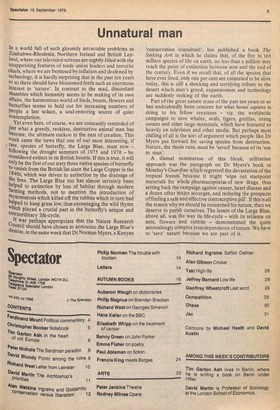Unnatural man
In a world full of such gloomily intractable problems as Zimbabwe-Rhodesia, Northern Ireland and British Leyland, where our television scfeens are nightly filled with the unappetising features of trade union leaders and terrorist Chiefs, where we are bemused by inflation and deafened by technology, it is hardly surprising that in the past ten years or so there should have blossomed forth such an enormous interest in `nature'. In contrast to the mad, discordant shambles which humanity seems to be making of its own affairs, the harmonious world of birds, beasts, flowers and butterflies seems to hold out for increasing numbers of People a last solace, a soul-restoring source of quiet Contemplation.
, Yet even here, of course, we are constantly reminded of just what a greedy, reckless, destructive animal man has become, the ultimate cuckoo in the nest of creation. This Week came the news that one of our most interesting, if , rare, species of butterfly, the Large Blue, must now — following the drought summers of 1975 and 1976 — be Considered extinct in its British haunts. If this is true, it will Only be the first of our sixty three native species of butterfly to vanish from the British list since the Large Copper in the 1840s, which was driven to extinction by the drainage of the fens. The Large Blue too has almost certainly been helped to extinction by loss of habitat through modern farming methods, not to mention the introduction of MYxomatosis which killed off the rabbits which in turn had helped to keep grass low, thus encouraging the wild thyme Which played a crucial part in the butterfly's unique and extraordinary life-cycle. It was perhaps appropriate that the Nature Research Council should have chosen to announce the Large Blue's demise, in the same week that Dr Norman Myers, a Kenyan 'conservation consultant', has published a book The Sinking Ark in which he claims that, of the five to ten million species of life on earth, no less than a million may reach the point of extinction between now and the end of the century. Even if we recall that, of all the species that have ever lived, only one per cent are estimated to be alive today, this is still a shocking and terrifying tribute to the desert which man's greed, expansionism and technology are suddenly making of the earth.
Part of the great nature craze of the past ten years or so has undoubtedly been concern for what homo sapiens is doing to his fellow creatures — viz, the worldwide campaigns to save whales, seals, tigers, gorillas, orang outans and other large mammals, which have featured so heavily on television and other media. But perhaps most chilling of all is the sort of argument which people like Dr Myers put forward for saving species from destruction. Nature, the thesis runs, must be 'saved' because of its 'use to man'.
A dismal summation of this bleak, utilitarian approach was the paragraph on Dr Myers's book in Monday's Guardian which regretted the devastation of the tropical forests' because it might 'wipe out startpoint materials for whole pharmacopoeias of new drugs, thus setting back the campaign against cancer, heart disease and a dozen other major scourges, and reducing the prospects of finding a safe and effective contraceptive If this is all the reason why we should be concerned for nature, then we deserve to perish ourselves. The lesson of the Large Blue, above all, was the way its life-cycle — with its reliance on ants, flowers and rabbits — demonstrated the quite astonishingly complex interdependence of nature. We have to 'save' nature because we are part of it,


































 Previous page
Previous page